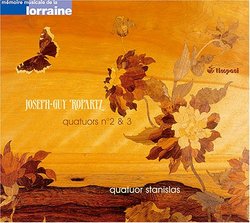| All Artists: Ropartz, Causse, Menut, Fenton, De Spengler Title: Quatuors Complete Recording 1 Members Wishing: 0 Total Copies: 0 Label: Timpani Original Release Date: 1/1/2006 Re-Release Date: 5/30/2006 Album Type: Import Genre: Classical Styles: Chamber Music, Historical Periods, Classical (c.1770-1830) Number of Discs: 1 SwapaCD Credits: 1 UPCs: 675754909420, 3377891310998 |
Search - Ropartz, Causse, Menut :: Quatuors Complete Recording 1
 | Ropartz, Causse, Menut Quatuors Complete Recording 1 Genre: Classical
|
Larger Image |
CD Details |
CD Reviews... Sébastien Melmoth | Hôtel d'Alsace, PARIS | 08/23/2007 (5 out of 5 stars) ".
Quoting Jonathan Woolf, "Seeing the words "First Recordings" is always an exciting event. But seeing them emblazoned on this recording of the second and third quartets of Ropartz took me aback. Why has this composer been so badly served by record companies? I dug out my copy of the first volume of the World's Encyclopaedia of Recorded Music, and emerged duly chastened. No Ropartz seems to have been recorded at all before about 1953. Perhaps a little something before his death in 1955, but not much. Neglect is not a word that can be levelled at Timpani, a courageous and intelligent company, a number of whose discs I've reviewed before. They pitch in with a complete edition of the six quartets of which this is the first to be issued. And what a fine and invigorating release it is. The quartets are presented out of chronological order, with the Third of 1925 first up. It may be purely coincidental that there's a rhythmic pattern vaguely reminiscent of the opening of Beethoven's Ninth but what's not in dispute is the songful lyricism of the writing. Ropartz's themes may be short but they're pregnant with thematic incident. Listen to the urgent and energetic - and just a touch clotted - conclusion to the first movement. Or to the way that the ensuing fast movement picks up the generated dynamism and sweeps us on; a perfect example of how rhythm can pull across movements. The slow folk-like melody that forms the B section of this scherzo is delightful. As much is true of the dreamlike slow movement. It has an ethereal quality, refined but never aloof, genuinely mysterious but profoundly human. The finale is light-hearted and full of playful élan; very French and clean-limbed. The earlier work dates from 1911-12. It's dedicated to Dukas, whose letter is reprinted in the booklet and it repays study for his acuity in recognising its salient strengths. There's a Debussian inheritance here no doubt, most evident in the powerfully concentrated slow introduction. There are recurrent fugal forays as well but ones that never becoming a chore to listen to. But as with the later work, striking energy and drive are motifs that mark out the quartet. The slow movement is lyric but not effusive, warm but not cloying; reflective calm is the key. And what a delight is that finale - the insouciant Monsieur Hulot swing of the rhythm, the viola-rich song and violin skelter of the writing. And how unexpected - and dramatically successful - is the slowing up for the reflective and calm moments before the conclusion. Both quartets are attractively recorded and played with flair and commitment by the Quatuor Stanislas. They follow in the august footsteps of the Capet and Calvet in this music- and acquit themselves well." . Individual Track Details: 1. Quartet for Strings no 3 in G major by Joseph Guy Ropartz Orchestra/Ensemble: Quatuor Stanislas Period: 20th Century Written: 1924; France 2. Quartet for Strings no 2 in D minor by Joseph Guy Ropartz Orchestra/Ensemble: Quatuor Stanislas Period: 20th Century Written: 1911; France ." |

 Track Listings (8) - Disc #1
Track Listings (8) - Disc #1